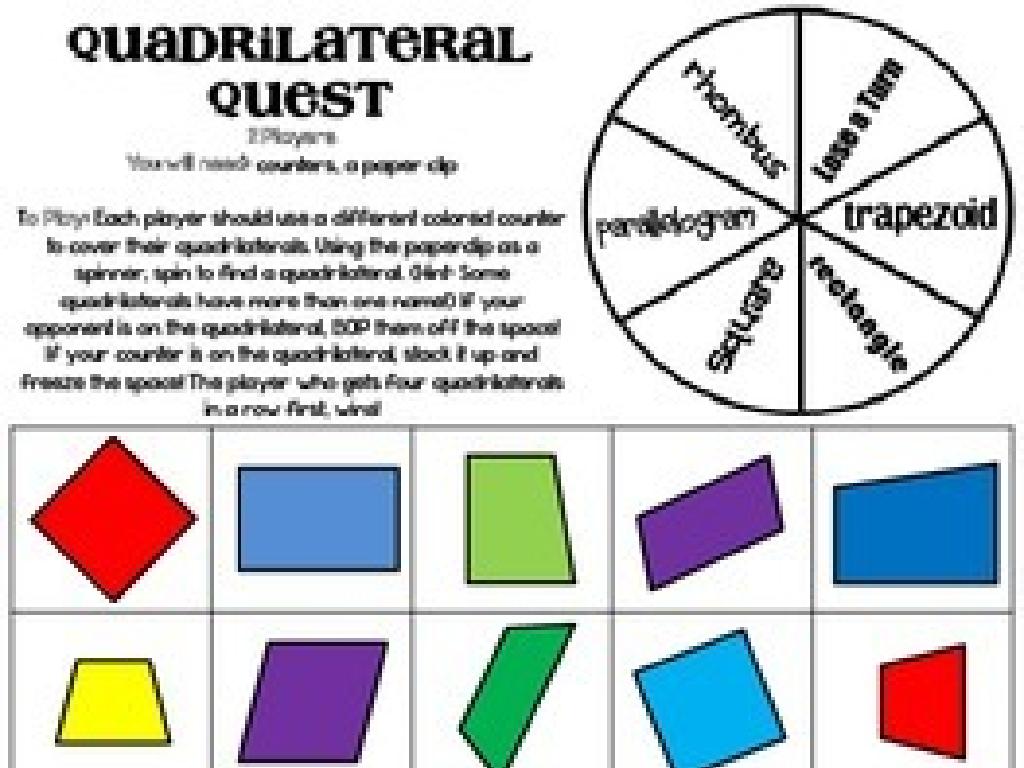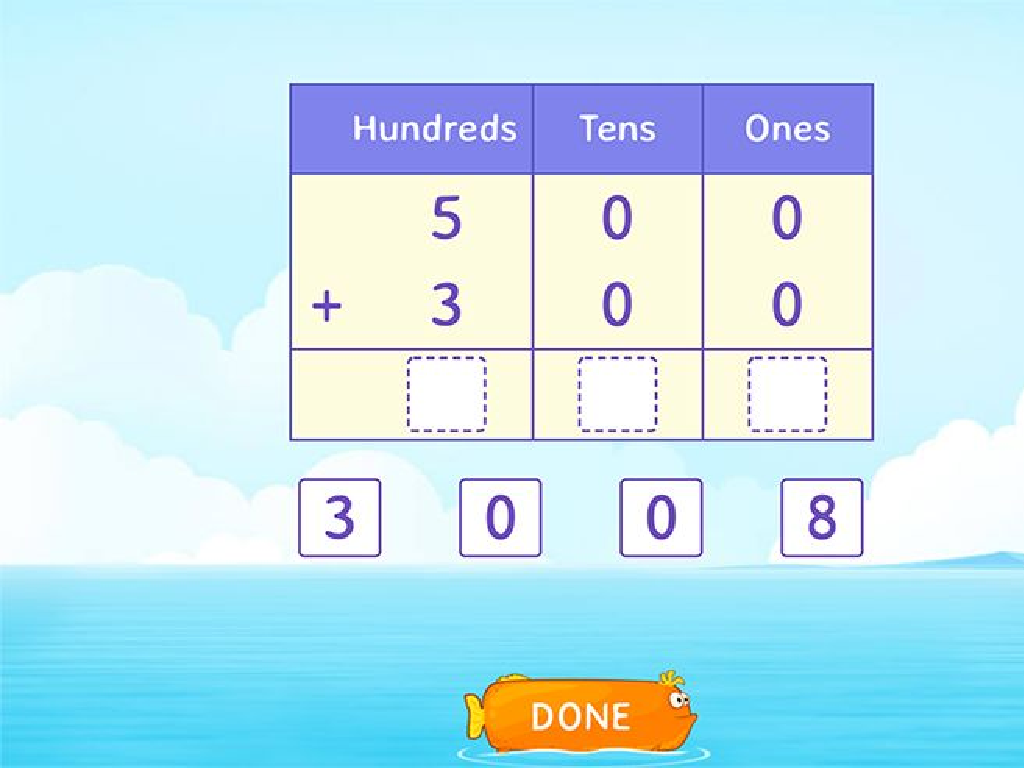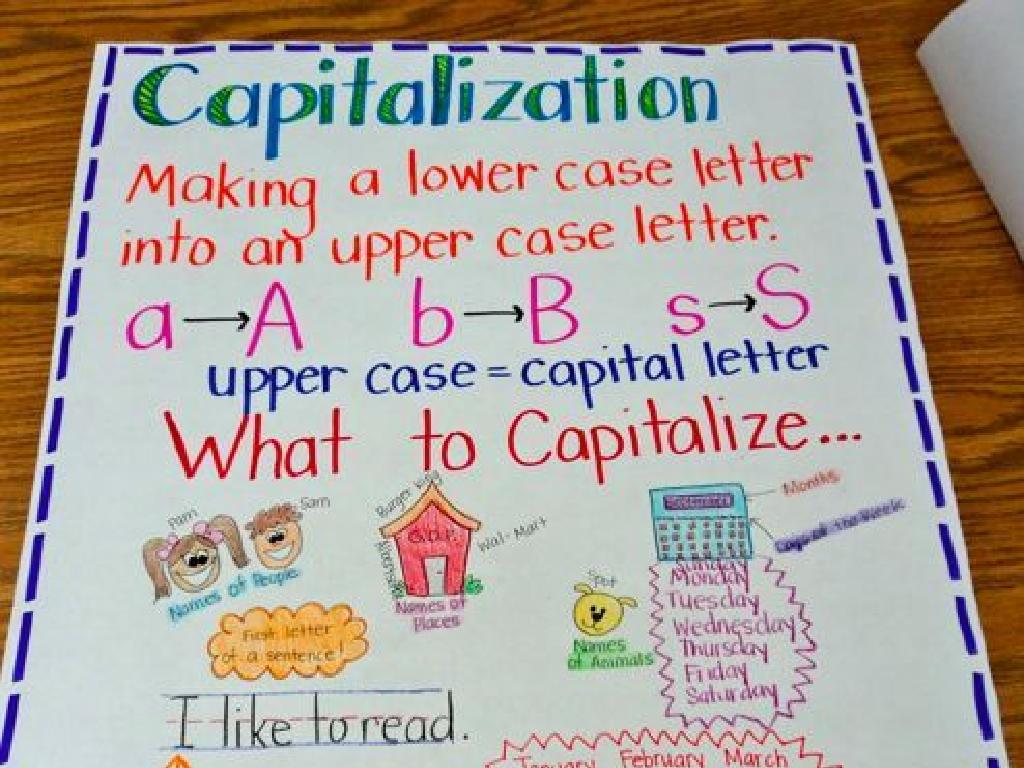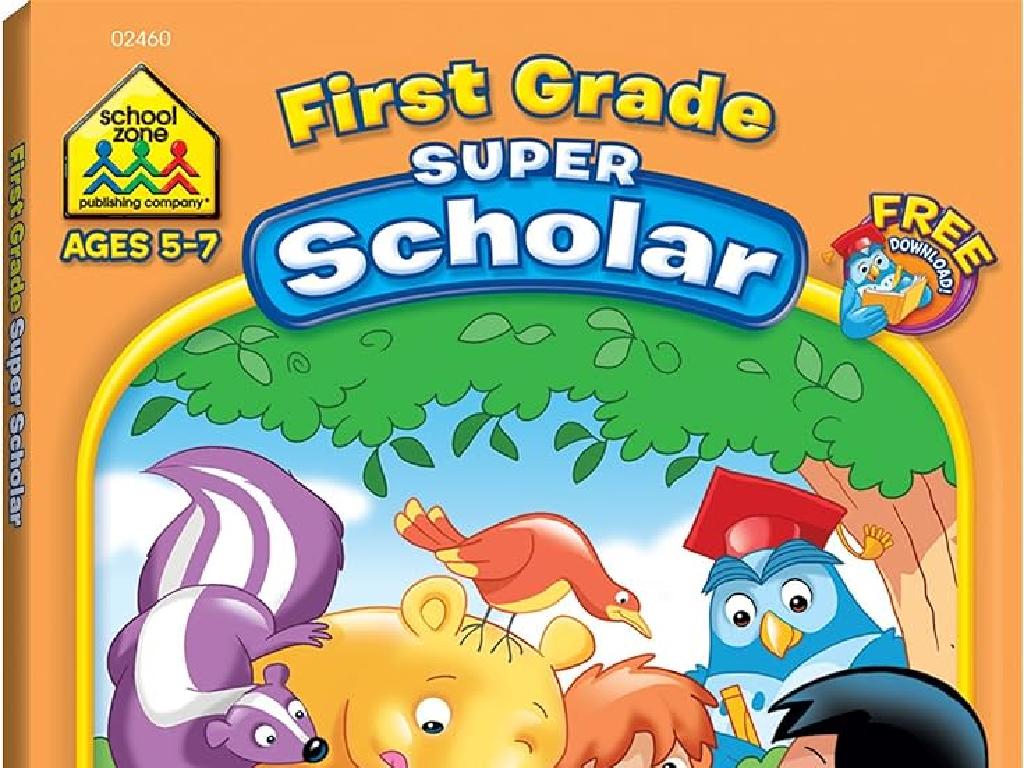Equal Parts
Subject: Math
Grade: Second grade
Topic: Fractions
Please LOG IN to download the presentation. Access is available to registered users only.
View More Content
Understanding Fractions: Equal Parts
– Whole vs. Parts concept
– A whole is one single complete thing. Parts are pieces of the whole.
– Introduction to Fractions
– Fractions represent parts of a whole.
– Focus: Equal Parts
– Equal parts are identical pieces of a whole.
– Examples of Equal Parts
– Pizza slices, orange wedges, and chocolate bars divided evenly.
|
This slide introduces the concept of fractions to second-grade students by explaining the idea of ‘whole’ and ‘parts’. Begin by showing a visual of a whole object, like an apple, and then show it cut into pieces to illustrate ‘parts’. Explain that fractions are a way to describe these parts of a whole. Emphasize the concept of ‘equal parts’ by using everyday examples such as dividing a pizza or an orange into equal slices. This will help students understand that each part must be the same size for it to be considered equal. Use simple, relatable examples to ensure comprehension and encourage students to think of their own examples of equal parts from their daily lives.
Understanding Equal Parts
– Equal parts are same-sized sections
– Like sharing a pizza equally among friends
– Dividing into equal parts
– When we cut a cake into 4 pieces, each piece should be the same size
– Each part is just as big as the others
– No piece is bigger or smaller; they are all the same
|
This slide introduces the concept of equal parts, a fundamental building block for understanding fractions. It’s important to use tangible examples that second graders can relate to, such as dividing a pizza or a cake into equal parts, to ensure they grasp the concept of ‘the same size.’ Emphasize that when we talk about equal parts, each section must be identical in size to the others, which is crucial when learning about fairness and sharing. During the lesson, consider using physical objects like playdough or paper to demonstrate dividing things into equal parts. This hands-on activity will help solidify the concept.
Understanding Equal Parts in Fractions
– Identifying equal parts in images
– Look at images, find ones with equal divisions
– Equal parts are essential for fractions
– Fractions represent equal parts of a whole
– Examples of equal and unequal parts
– Pizza slices vs. unevenly cut cake
– Significance of equal parts in daily life
– Fair sharing of snacks, time, and resources
|
This slide aims to help students visually understand the concept of equal parts, which is fundamental in learning about fractions. Start by showing pictures of various objects, some divided into equal parts and others not. Ask students to identify which ones are divided equally. Explain that for a shape to be split into fractions, the parts must be equal, as fractions represent equal parts of a whole. Provide relatable examples, such as equally cut pizza slices versus an unevenly cut cake, to illustrate the importance of equal division. Discuss how understanding equal parts is useful in everyday situations, like sharing snacks or dividing time for activities. Encourage students to think of their own examples where equal parts are important.
Fractions in Everyday Life
– Fractions are all around us
– Sharing food involves fractions
– When we split a pizza, we are making fractions like 1/2 or 1/4
– Examples: pizza and sandwiches
– Half a sandwich (1/2) or a slice of pizza cut into 4 pieces (1/4 each)
– Understanding halves and quarters
– Knowing fractions helps us divide things equally
|
This slide introduces students to the concept of fractions in a context they can easily understand and relate to – sharing food. It’s important to explain that fractions are a way to describe parts of a whole in a precise way. Use tangible examples like cutting a sandwich in half or a pizza into quarters to illustrate the idea of halves (1/2) and quarters (1/4). Emphasize that understanding fractions is essential for dividing things equally and fairly, which is a common situation in their daily lives. Encourage students to think of other examples where they use fractions without realizing it, and be prepared to discuss these examples in the next class.
Let’s Practice Together: Equal Parts
– Identify shapes with equal parts
– Look for shapes split into identical sections
– Color the equal parts of shapes
– Use colors to highlight these equal sections
|
This slide is designed for a class activity to help second-grade students understand the concept of equal parts in the context of fractions. Begin by explaining that when a shape is divided into equal parts, each part is the same size. Show examples of shapes divided into equal and unequal parts. Then, provide students with shapes on paper and have them color in the parts that are equal. This visual and interactive approach will help solidify their understanding of equal parts. For the activity, consider having different shapes for different groups, such as squares divided into halves or fourths, and circles divided into thirds or sixths, to provide a variety of examples.
Your Turn to Create: Equal Parts
– Draw lines to divide shapes
– Make all parts equal in size
– Count the number of equal parts
– How many parts did you create?
– Think about different ways to divide
– Can a shape be divided in more than one way?
|
This slide is an interactive activity for students to apply their understanding of equal parts, a fundamental concept in learning fractions. Provide students with shapes such as circles, squares, and rectangles, and ask them to draw lines that divide the shapes into equal parts. Encourage them to explore different ways to make equal parts, such as dividing a square into 4 equal parts by drawing 2 lines. After they have finished drawing, prompt them to count and record the number of parts they’ve created. Discuss with the class the various methods they used to divide the shapes and whether all methods resulted in equal parts. This activity not only reinforces the concept of equal parts but also prepares students for understanding fractions as parts of a whole.
Class Activity: Equal Parts Hunt
– Let’s explore the classroom together
– Find items that can be split equally
– Think about how to divide them
– Can it be divided into 2, 4, or more equal parts?
– Share your findings with everyone
|
This activity is designed to help students understand the concept of equal parts in a fun and interactive way. Encourage the students to look around the classroom for objects that can be divided into equal parts, such as a piece of paper, an apple, or a pizza drawn on the board. They should consider how these items can be split into halves, quarters, or other fractions. Once they find an item, ask them to explain how it can be divided equally and why it’s important that the parts are equal for it to be a fair share. This will help them grasp the practical application of fractions in everyday life. Prepare to facilitate the discussion and ensure each student has a chance to participate. Possible items for the activity could include scissors (handles and blades as two equal parts), books (divided into halves), or even a group of students (divided into equal teams).
Review: Equal Parts and Fractions
– Understanding equal parts
– Equal parts are identical sections of a whole.
– Fractions represent parts
– A fraction shows how many parts of a whole we have.
– Examples of equal parts
– Pizza slices, orange segments, and chocolate bars.
– Applying knowledge of fractions
– How would you divide a cake into equal parts for 4 friends?
|
In this lesson, we’ve learned that equal parts are sections of a whole that are exactly the same size. Fractions are a way to describe these parts. We’ve looked at everyday items like pizzas and oranges to understand how they can be divided into equal parts. As we conclude, encourage the students to think of other items that can be divided into equal parts and how fractions are used in real life. For example, cutting a sandwich into halves or quarters. Review by asking students to draw or identify fractions in different scenarios, reinforcing the concept of equal parts.
Homework Challenge: Equal Parts Practice
– Take your worksheet home
– Practice dividing shapes
– Divide circles, squares, etc.
– Make sure parts are equal
– Each part should be the same size
– Bring worksheet back to class
|
This homework assignment is designed to reinforce the concept of equal parts, which is a foundational idea in understanding fractions. Students are provided with a worksheet that contains various shapes. They are tasked with dividing these shapes into equal parts, ensuring that each part is the same size. This exercise will help them visually comprehend what it means for parts to be equal, an essential skill for grasping more complex fraction concepts in the future. Encourage students to try dividing different types of shapes to challenge themselves. Remind them to bring their completed worksheets back to class for discussion and further learning.






